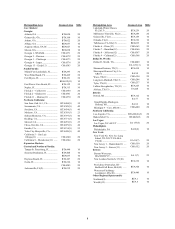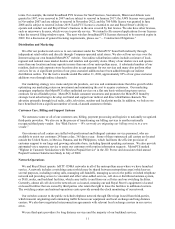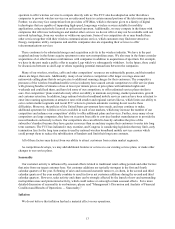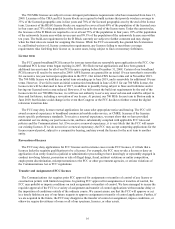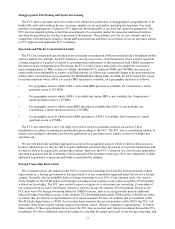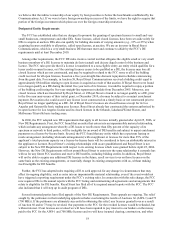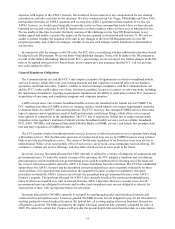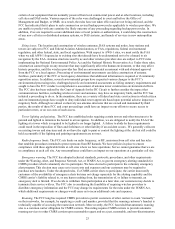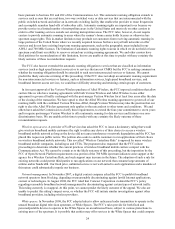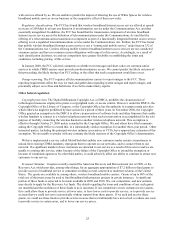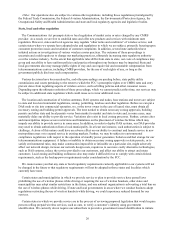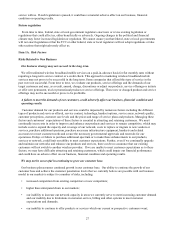Metro PCS 2008 Annual Report Download - page 26
Download and view the complete annual report
Please find page 26 of the 2008 Metro PCS annual report below. You can navigate through the pages in the report by either clicking on the pages listed below, or by using the keyword search tool below to find specific information within the annual report.17
Disaggregation, Partitioning and Spectrum Leasing
The FCC allows spectrum and service areas to be subdivided, partitioned, or disaggregated, geographically or by
bandwidth, with each resulting license covering a smaller service area and/or including less spectrum. Any such
partition or disaggregation is subject to FCC approval, which generally is received, but cannot be guaranteed. The
FCC also has adopted policies to facilitate development of a secondary market for unused or underused wireless
spectrum by permitting the leasing of spectrum to third parties. These policies provide us, new entrants, and our
competitors with alternative means to obtain additional spectrum and allow us to dispose of excess spectrum, subject
to FCC approval and applicable FCC conditions.
Spectrum and Market Concentration Limits
The FCC has certain policies intended to prevent undue concentration of the terrestrial wireless broadband mobile
services market. For example, the FCC conducts a case-by-case review of all transactions where wireless spectrum
is being assigned or a transfer of control is occurring where both parties to the transaction hold CMRS spectrum in
the same or in an overlapping area. Previously, the FCC would screen a transaction for competitive concerns if,
upon consummation, 95 MHz or more of cellular, broadband PCS, enhanced SMR, and 700 MHz spectrum in a
single market was attributable to a party or affiliated group, or if there was a material change in the post-transaction
market share concentrations as measured by the Herfindahl-Hirschman Index. In 2008, the FCC revised this screen
to include situations where AWS-1 or certain BRS spectrum is available, on a geographic area basis as follows:
• For geographic areas in which AWS-1 and certain BRS spectrum is available, the Commission’s initial
spectrum screen is 145 MHz.
• For geographic areas in which AWS-1 is available but certain BRS is not available, the Commission’s
initial spectrum screen is 125 MHz.
• For geographic areas in which certain BRS spectrum is available but AWS-1 is not available, the
Commission’s initial spectrum screen is 115 MHz.
• For geographic areas in which neither BRS spectrum or AWS-1 is available, the Commission’s initial
spectrum screen is 95 MHz.
The FCC also stated that it now will apply this revised screen to spectrum acquired via auction. These
benchmarks are subject to pending reconsideration proceedings at the FCC. The FCC also is considering whether to
initiate a proceeding to eliminate case-by-case application of a spectrum screen entirely in favor of a bright-line
spectrum cap.
We are well below the spectrum aggregation screen in the geographic areas in which we hold or have access to
licenses which means we may be able to acquire additional spectrum either by auction or in private transactions and
we may be able to be acquired by certain other carriers. However, the FCC’s retention of a case-by-case approach to
spectrum acquisition and the continuing revision upward of the spectrum screen may allow our competitors to make
additional acquisitions of spectrum and further consolidate the industry.
Foreign Ownership Restrictions
The Communications Act authorizes the FCC to restrict the ownership levels held by foreign nationals or their
representatives, a foreign government or its representative or any corporation organized under the laws of a foreign
country. Generally, the law prohibits indirect foreign ownership of over 25% of our common stock. Our stock is
freely tradable on the NYSE and as such foreign ownership of our common stock could exceed this 25% threshold
without our knowledge. The FCC may revoke licenses, or require us to restructure our ownership, if ownership of
our common stock by non-United States citizens or entities exceeds the statutory 25% benchmark. However, the
FCC may waive the foreign ownership limits for CMRS licensees, such as us, and generally permits additional
indirect foreign ownership in excess of the statutory 25% benchmark particularly if that interest is held by an entity
or entities that are citizens of, representatives of or organized under the laws of countries that are members of the
World Trade Organization, or WTO. For investors from countries that are not members of the WTO, the FCC will
determine if the home country extends reciprocal treatment, called “effective competitive opportunities,” to United
States entities. If these opportunities do not exist, the FCC may not permit such foreign investment beyond the 25%
benchmark. We have established internal procedures to ascertain the nature and extent of our foreign ownership, and



